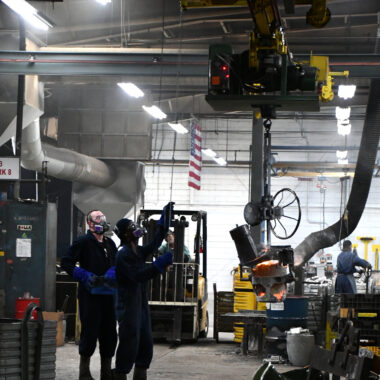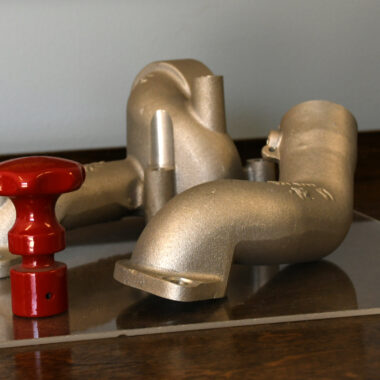Grasping About Aluminum Casting: Techniques Demystified
Grasping About Aluminum Casting: Techniques Demystified
Blog Article
Discover the World of Light Weight Aluminum Casting: Insider Secrets and Approaches
In the realm of manufacturing, light weight aluminum spreading stands as a critical procedure, vital for the development of a large range of products. As we navigate through the world of light weight aluminum spreading, there exists a realm of insider tricks and techniques that can elevate the high quality of the last products and streamline the production process.

The Fundamentals of Light Weight Aluminum Casting
Aluminum spreading, a basic process in manufacturing, entails the putting of liquified aluminum right into a mold to accomplish wanted shapes and frameworks. This versatile method is commonly utilized across different markets as a result of aluminum's phenomenal properties such as high strength-to-weight ratio, corrosion resistance, and thermal conductivity.
The process begins with the melting of light weight aluminum in a heater at temperature levels exceeding 1220 ° F(660 ° C ) Once the aluminum reaches its fluid state, it is put into a pre-designed mold and mildew tooth cavity. The mold and mildew, normally made from materials like steel or sand, determines the last shape of the cast light weight aluminum component.
After putting, the aluminum is entrusted to solidify and cool within the mold - about aluminum casting. This cooling duration is crucial as it figures out the honesty and top quality of the final product. Once strengthened, the mold is eliminated, exposing the newly formed light weight aluminum casting
Expert Tips for Effective Casting
To achieve optimal results in light weight aluminum casting, careful attention to information during the mold and mildew layout phase is imperative for guaranteeing effective outcomes. One expert tip for effective casting is to meticulously consider the gating system. The style of eviction system plays a critical function in controlling the flow of liquified aluminum right into the mold tooth cavity, making certain appropriate dental filling and lessening issues like air entrapment. Additionally, maintaining the proper steel temperature is crucial for accomplishing high-quality spreadings. Monitoring and managing the steel temperature level throughout the casting process can assist stop concerns such as premature solidification or porosity in the end product.
Furthermore, one more vital pointer is to properly prepare the mold surface area. A well-prepared mold surface area can add to better steel circulation, minimized disturbance, and boosted surface area finish on the actors part. This preparation might include utilizing coatings or therapies to boost mold launch and stop metal/mold interactions that can result in defects. By paying close attention to these expert ideas, manufacturers can boost the quality and efficiency of their aluminum casting processes.
Advanced Strategies in Light Weight Aluminum Spreading
Making use of ingenious approaches and advanced techniques, the world of aluminum casting has actually seen a considerable development towards advanced methods that press the borders of conventional techniques. One such technique is vacuum cleaner casting, which involves developing a vacuum cleaner environment to get rid of air from the mold and mildew cavity, causing better and more complex spreadings with minimized porosity. In addition, financial investment spreading, additionally recognized as lost-wax spreading, is a refined technique that enables for thin walls and intricate forms, causing accurate and thorough light weight aluminum parts.

In addition, advanced simulation software application plays a crucial function in optimizing spreading layouts and forecasting potential flaws, permitting changes to be made prior to the actual casting procedure click here now starts. By embracing these sophisticated strategies, makers can elevate their aluminum casting capabilities to new elevations, satisfying the needs of modern-day industries with precision and technology.
Understanding Various Casting Approaches
In the realm of manufacturing, a comprehensive understanding of numerous casting approaches is necessary for accomplishing optimal results in steel fabrication procedures. Various casting techniques supply unique advantages and are picked based upon factors such as the intricacy of the layout, production quantity, material requirements, and expense considerations. Among one of the most typical spreading techniques is sand casting, where a mold is developed utilizing sand as the main product. Sand spreading is functional, cost-efficient, and suitable for creating huge components.
One more preferred spreading technique is pass away spreading, which entails injecting molten metal right into a mold dental caries under this page high pressure. Pass away casting is recognized for its high precision, smooth surface coating, and the capability to create intricate forms with tight resistances. Gravity spreading, on the various other hand, depends on gravity to fill up the mold and mildew tooth cavity with molten metal. This method is ideal for producing simpler shapes and is cost-effective for tiny to tool production runs. By understanding the subtleties of various spreading techniques, producers can make enlightened decisions to enhance their manufacturing procedures and achieve the desired outcomes.
Making The Most Of Efficiency in Spreading Operations
With a solid grip of the subtleties of various spreading methods, makers can enhance their operations to enhance effectiveness in steel construction processes. Making the most of performance in casting operations needs a methodical method that concentrates on enhancing every step of the spreading process.
Moreover, purchasing sophisticated modern technology and devices can considerably improve efficiency in casting operations. Automated systems, robotics, and computer-aided design (CAD) software application can improve procedures, minimize mistakes, and boost result. Furthermore, training employees on the most recent techniques and finest practices can likewise contribute to taking full helpful resources advantage of effectiveness in casting procedures.
Routine maintenance of equipment and tools is crucial to minimize and prevent breakdowns downtime - about aluminum casting. Executing a proactive upkeep routine can aid determine potential concerns prior to they escalate, making sure smooth procedures and uninterrupted manufacturing. On the whole, by focusing on effectiveness and constant improvement, makers can optimize their casting procedures and stay affordable in the industry

Verdict
To conclude, the globe of aluminum casting uses a vast array of chances for those aiming to produce long lasting and intricate steel objects. By understanding the basics, making use of insider ideas, and checking out innovative strategies, people can achieve wonderful success in their casting undertakings. Comprehending the various spreading methods and maximizing performance in procedures are vital elements to attaining top quality cause aluminum casting. With commitment and practice, one can truly unlock the capacity of this functional metalworking procedure.
One such method is vacuum cleaner casting, which includes developing a vacuum environment to get rid of air from the mold and mildew cavity, leading to higher high quality and even more detailed spreadings with minimized porosity (about aluminum casting). Additionally, financial investment spreading, additionally known as lost-wax spreading, is a polished method that allows for thin wall surfaces and complex forms, resulting in specific and thorough light weight aluminum parts
One of the most usual spreading techniques is sand casting, where a mold and mildew is produced making use of sand as the key material.An additional prominent spreading approach is die casting, which entails injecting molten steel into a mold and mildew cavity under high pressure. Recognizing the different spreading techniques and enhancing performance in operations are key parts to accomplishing top notch results in aluminum spreading.
Report this page